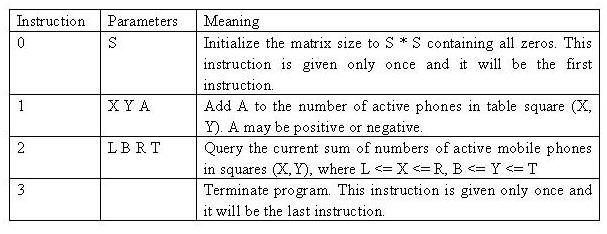POJ 1195 二维树状数组
2016-09-30 19:40
393 查看
Mobile phones
Description
Suppose that the fourth generation mobile phone base stations in the Tampere area operate as follows. The area is divided into squares. The squares form an S * S matrix with the rows and columns numbered from 0 to S-1. Each square contains a base station. The number of active mobile phones inside a square can change because a phone is moved from a square to another or a phone is switched on or off. At times, each base station reports the change in the number of active phones to the main base station along with the row and the column of the matrix.
Write a program, which receives these reports and answers queries
about the current total number of active mobile phones in any
rectangle-shaped area.
Input
The
input is read from standard input as integers and the answers to the
queries are written to standard output as integers. The input is encoded
as follows. Each input comes on a separate line, and consists of one
instruction integer and a number of parameter integers according to the
following table.

The values will always be in range, so there is no need to check
them. In particular, if A is negative, it can be assumed that it will
not reduce the square value below zero. The indexing starts at 0, e.g.
for a table of size 4 * 4, we have 0 <= X <= 3 and 0 <= Y <=
3.
Table size: 1 * 1 <= S * S <= 1024 * 1024
Cell value V at any time: 0 <= V <= 32767
Update amount: -32768 <= A <= 32767
No of instructions in input: 3 <= U <= 60002
Maximum number of phones in the whole table: M= 2^30
Output
Your
program should not answer anything to lines with an instruction other
than 2. If the instruction is 2, then your program is expected to answer
the query by writing the answer as a single line containing a single
integer to standard output.
Sample Input
Sample Output
Source
IOI 2001
题意:
在一个二维平面内的所有点,共有三种操作,0 S表示把S*S区域内的点的值清零;X,Y,A表示将点(X,Y)的值加A;L,B,R,T表示求(L,B)~(R,T)之间的所有的点的值之和
代码:
| Time Limit: 5000MS | Memory Limit: 65536K | |
| Total Submissions: 18489 | Accepted: 8558 |
Suppose that the fourth generation mobile phone base stations in the Tampere area operate as follows. The area is divided into squares. The squares form an S * S matrix with the rows and columns numbered from 0 to S-1. Each square contains a base station. The number of active mobile phones inside a square can change because a phone is moved from a square to another or a phone is switched on or off. At times, each base station reports the change in the number of active phones to the main base station along with the row and the column of the matrix.
Write a program, which receives these reports and answers queries
about the current total number of active mobile phones in any
rectangle-shaped area.
Input
The
input is read from standard input as integers and the answers to the
queries are written to standard output as integers. The input is encoded
as follows. Each input comes on a separate line, and consists of one
instruction integer and a number of parameter integers according to the
following table.

The values will always be in range, so there is no need to check
them. In particular, if A is negative, it can be assumed that it will
not reduce the square value below zero. The indexing starts at 0, e.g.
for a table of size 4 * 4, we have 0 <= X <= 3 and 0 <= Y <=
3.
Table size: 1 * 1 <= S * S <= 1024 * 1024
Cell value V at any time: 0 <= V <= 32767
Update amount: -32768 <= A <= 32767
No of instructions in input: 3 <= U <= 60002
Maximum number of phones in the whole table: M= 2^30
Output
Your
program should not answer anything to lines with an instruction other
than 2. If the instruction is 2, then your program is expected to answer
the query by writing the answer as a single line containing a single
integer to standard output.
Sample Input
0 4 1 1 2 3 2 0 0 2 2 1 1 1 2 1 1 2 -1 2 1 1 2 3 3
Sample Output
3 4
Source
IOI 2001
题意:
在一个二维平面内的所有点,共有三种操作,0 S表示把S*S区域内的点的值清零;X,Y,A表示将点(X,Y)的值加A;L,B,R,T表示求(L,B)~(R,T)之间的所有的点的值之和
代码:
//树状数组模板
#include<iostream>
#include<cstdio>
#include<cstring>
using namespace std;
int flag,X,Y,A,L,B,R,T,S;
int squ[1050][1050];
int lowbit(int x)
{
return x&(-x);
}
void add(int idx,int idy,int val)
{
for(int i=idx;i<=1024;i+=lowbit(i))
{
for(int j=idy;j<=1024;j+=lowbit(j))
{
squ[i][j]+=val;
}
}
}
int sum(int idx,int idy)
{
int s=0;
for(int i=idx;i>0;i-=lowbit(i))
{
for(int j=idy;j>0;j-=lowbit(j))
{
s+=squ[i][j];
}
}
return s;
}
int ans(int x1,int y1,int x2,int y2)
{
return (sum(x2,y2)-sum(x1-1,y2)-sum(x2,y1-1)+sum(x1-1,y1-1));
}
int main()
{
while(scanf("%d",&flag)&&flag!=3)
{
if(flag==0)
{
scanf("%d",&S);
memset(squ,0,sizeof(squ));
}
else if(flag==1)
{
scanf("%d%d%d",&X,&Y,&A);
if(A>=0)
add(X+1,Y+1,A);
else
{
int num=ans(X+1,Y+1,X+1,Y+1);
add(X+1,Y+1,num+A>0?A:-num);
}
}
else if(flag==2)
{
scanf("%d%d%d%d",&L,&B,&R,&T);
printf("%d\n",ans(L+1,B+1,R+1,T+1));
}
}
return 0;
}
相关文章推荐
- poj 1195 Mobile phones(二维树状数组基础)
- poj 1195 Mobile phones 二维树状数组
- poj 1195 mobile phones 二维树状数组
- POJ 1195 Mobile phones【二维树状数组】
- POJ 1195 二维线段树||二维树状数组
- POJ-1195 Mobile phones 二维树状数组
- POJ_1195 Mobile phones 【二维树状数组】
- POJ 1195 Mobile phones 二维树状数组
- poj_1195Mobile phones,二维树状数组
- POJ-1195 Mobile phones(二维树状数组裸题)
- POJ 1195 - Mobile phones 二维树状数组(单点更新..区间查询)
- poj1195 mobile phones 【二维树状数组】
- POJ 1195 二维树状数组
- POJ 1195 Mobile phones——二维树状数组
- Poj 1195 二维树状数组
- 【二维树状数组】POJ 1195
- poj 1195 Mobile phones(二维的树状数组)得好好看。。。
- poj 1195 二维树状数组
- poj 1195 二维树状数组 及二维树状数组模板
- poj 1195:Mobile phones(二维树状数组,矩阵求和)
